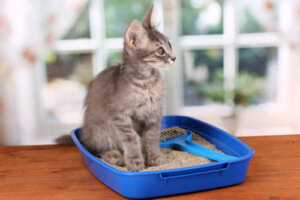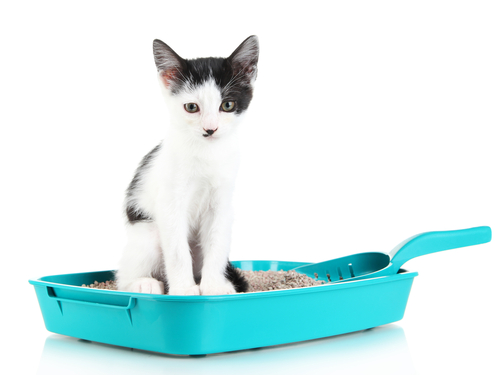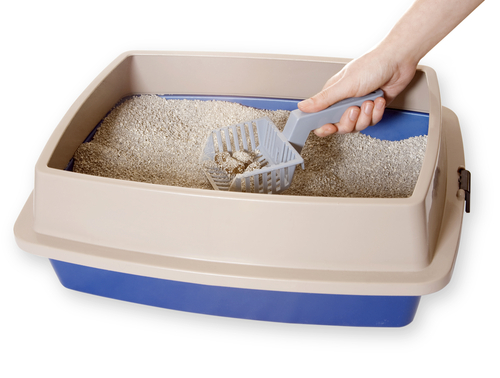How to Clean Your Cat's Litter Box

Your cat’s litter box shouldn’t be placed next to noisy or heat-radiating appliances, such as the oven or washing machine. Noise can make a cat nervous, while the heat from a dryer or oven can increase the smell of her litter box.
Place the litter box away from its feeders and drinkers. Cats don’t like their bathroom smells near their food!
If the litter box is in a closet or bathroom, make sure the door is always open.
Choose a litter or sand that suits your cat’s needs. Products to minimize odors, such as deodorants, may scare your little friend away. For that reason, it isn’t a good idea to place them near their litter box.
To prevent the smell, you can put a thin layer of baking soda on the bottom of the box. If your cat’s litter box is dirty or smells too bad, they won’t use it.
Some advice
Some cats, especially those that are quite shy, may prefer a covered litter box. These types of products have some advantages and disadvantages.
Covered sandboxes reduce the amount of garbage that usually comes out of the box. However, they can turn out to be somewhat uncomfortable for cats, as they sometimes don’t have enough space to turn or dig. In addition, as they’re covered, they must be cleaned more often and the strong odor can affect your health and that of your pet.
Clean the box frequently. The sand should be changed twice a week. But perhaps, depending on the circumstances, you may need to do it every other day, or only once a week.
If you clean the box every day, you may only need to change the clumped litter every two to three weeks. If you notice that there’s a bad smell or much of the sand is wet or clumped, it’s definitely time for a change.
It isn’t necessary to carry your cat to the box and move its paws back and forth. In fact, this isn’t at all recommended, as it can be an unpleasant experience for them. However, if you move house, you may need to show your cat where the box is, although their sensitive nose will probably find it first!
If your little friend starts going to the toilet outside the litter box, the first thing to do is call the vet. Many medical conditions can cause a change in your cat’s habits. If not, their reluctance is most likely due to behavioral problems, which you’ll need to resolve. But remember, punishment is not the solution.
Don’t forget, cats don’t like surprises. The worst thing you can do, when it comes to changing brands or types of sand, is to dump its contents in its current box and fill it with a different layer.
How to change the sand?
It’s essential to remember that the feces and urine in your cat’s litter box can be harmful to the person who’s going to clean them. So before starting this task, take a pair of rubber gloves and a mask. The mask helps reduce the risk of toxoplasmosis, a very dangerous virus, especially if you are pregnant. If so, it’s better to have someone else do it.
Remove all the sand from the box and put the waste in a bag. Wash the box with detergent or disinfectant. Make sure the product isn’t toxic to animals.
Sweep, disinfect and ventilate the place where the box is placed. It’s also very important that you wash and disinfect the shovel you collect the sand with
Finally, fill your pet’s box with sand. The layer shouldn’t exceed two centimeters in depth. In fact, some long-haired cats prefer less.
Your cat’s litter box shouldn’t be placed next to noisy or heat-radiating appliances, such as the oven or washing machine. Noise can make a cat nervous, while the heat from a dryer or oven can increase the smell of her litter box.
Place the litter box away from its feeders and drinkers. Cats don’t like their bathroom smells near their food!
If the litter box is in a closet or bathroom, make sure the door is always open.
Choose a litter or sand that suits your cat’s needs. Products to minimize odors, such as deodorants, may scare your little friend away. For that reason, it isn’t a good idea to place them near their litter box.
To prevent the smell, you can put a thin layer of baking soda on the bottom of the box. If your cat’s litter box is dirty or smells too bad, they won’t use it.
Some advice
Some cats, especially those that are quite shy, may prefer a covered litter box. These types of products have some advantages and disadvantages.
Covered sandboxes reduce the amount of garbage that usually comes out of the box. However, they can turn out to be somewhat uncomfortable for cats, as they sometimes don’t have enough space to turn or dig. In addition, as they’re covered, they must be cleaned more often and the strong odor can affect your health and that of your pet.
Clean the box frequently. The sand should be changed twice a week. But perhaps, depending on the circumstances, you may need to do it every other day, or only once a week.
If you clean the box every day, you may only need to change the clumped litter every two to three weeks. If you notice that there’s a bad smell or much of the sand is wet or clumped, it’s definitely time for a change.
It isn’t necessary to carry your cat to the box and move its paws back and forth. In fact, this isn’t at all recommended, as it can be an unpleasant experience for them. However, if you move house, you may need to show your cat where the box is, although their sensitive nose will probably find it first!
If your little friend starts going to the toilet outside the litter box, the first thing to do is call the vet. Many medical conditions can cause a change in your cat’s habits. If not, their reluctance is most likely due to behavioral problems, which you’ll need to resolve. But remember, punishment is not the solution.
Don’t forget, cats don’t like surprises. The worst thing you can do, when it comes to changing brands or types of sand, is to dump its contents in its current box and fill it with a different layer.
How to change the sand?
It’s essential to remember that the feces and urine in your cat’s litter box can be harmful to the person who’s going to clean them. So before starting this task, take a pair of rubber gloves and a mask. The mask helps reduce the risk of toxoplasmosis, a very dangerous virus, especially if you are pregnant. If so, it’s better to have someone else do it.
Remove all the sand from the box and put the waste in a bag. Wash the box with detergent or disinfectant. Make sure the product isn’t toxic to animals.
Sweep, disinfect and ventilate the place where the box is placed. It’s also very important that you wash and disinfect the shovel you collect the sand with
Finally, fill your pet’s box with sand. The layer shouldn’t exceed two centimeters in depth. In fact, some long-haired cats prefer less.
This text is provided for informational purposes only and does not replace consultation with a professional. If in doubt, consult your specialist.










